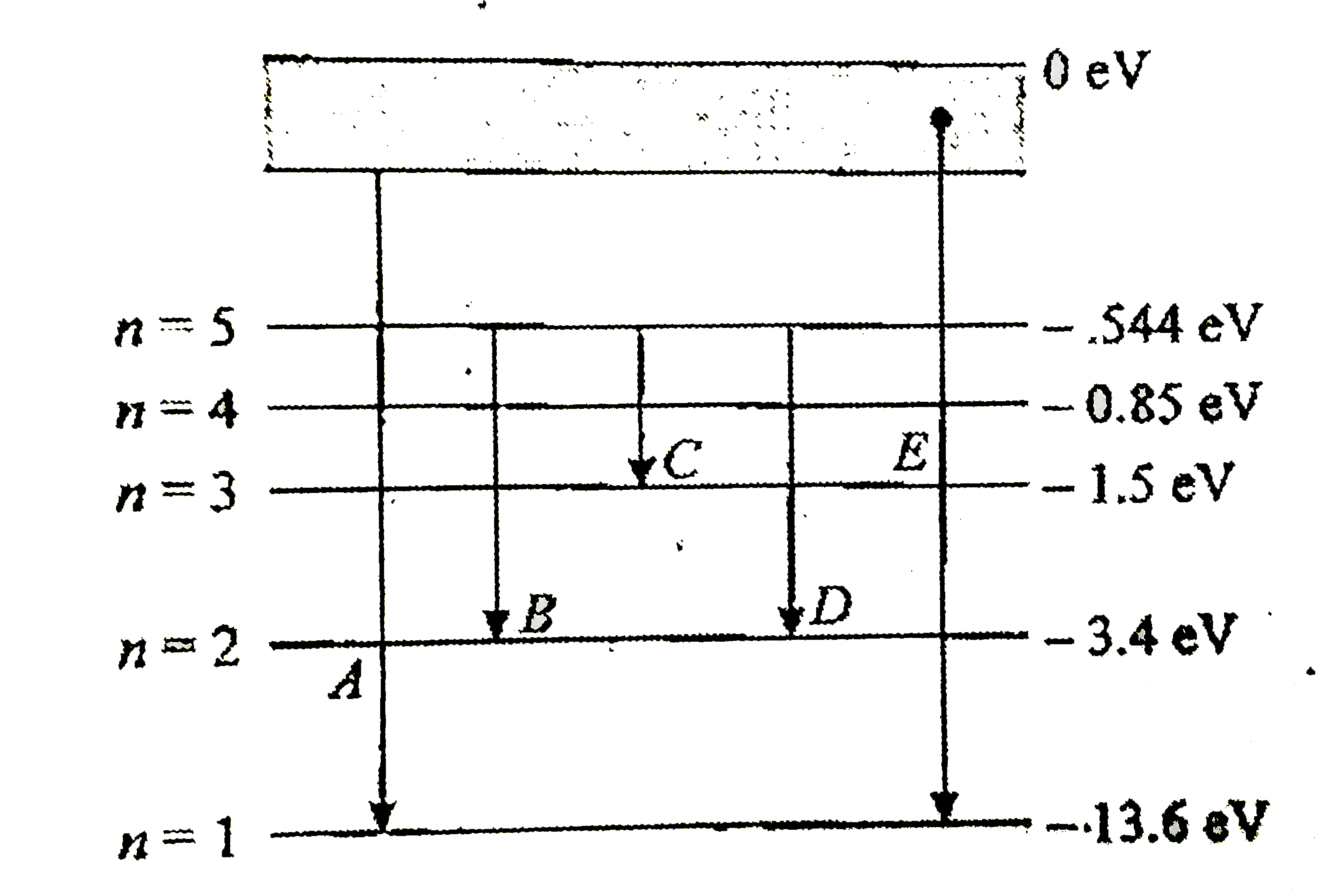Complete Solutions to Exercise 2 (MISCELLANEOUS PROBLEMS) of chapter ATOMS, MOLECULES AND NUCLEI of Class 12 book with complete answers and questions
| Class 12 | PHYSICS |
| Chapter | ATOMS, MOLECULES AND NUCLEI |
| MHTCET PREP GUIDE | Exercise 2 (MISCELLANEOUS PROBLEMS) |
| Number Of Questions | 26 |
| Academic Year | 2023-24 |
To explain theory of hydrogen atom, Bohr considered
02:00View SolutionThe ratio of kinetic energy to the total energy of an electron in a Bohr orbit of the hydrogen atom, is
03:06View SolutionIn a hypothetical Bohr hydrogen atom, the mass of the electron is double then
02:36View SolutionAn electron jumps from the `4th` orbit to the `2nd` orbit of hydrogen atom. Given the Rydberg's constant `R = 10^(5) cm^(-1)`. The frequency in `Hz` of the emitted radiation will be
02:36View SolutionIn the following figure the energy levels of hydroge atom have been shown along with some transitions marked A, B,C,D and E.The transitionsy A,B and C respectively represent:
 04:42View Solution
04:42View SolutionAn hydrogen atom moves with a velocity u and makes a head on inelastic collision with another stationary H-atom. Both atoms are in ground state before collision. The minimum value of u if one of them is to be given a minimum excitation energy is
03:02View SolutionA hydrogen like ion having wavelength difference between first Balmer and Lyman series equal 593 Å has Z equal to
05:22View SolutionIn the Bohr's model of hydrogen-like atom the force between the nucleus and the electron is modified as `F=(e^(2))/(4piepsi_(0))((1)/(r^(2))+(beta)/(r^(3)))`, where `beta` is a constant. For this atom, the radius of the nth orbit in terms of the bohr radius `(a_(0)=(epsi_(0)h^(2))/(mpie^(2)))` is
View SolutionIn rutherford's experiment, the mumber of alpha-particles scattered through an angle of `90^(@)` is 28 per minute. Then,the number of particles scattered through an angle of `60^(@)`per minute by the same nucleus is
02:15View SolutionA small particle of mass m move in such a way the potential energy `(U = (1)/(2) m^(2) omega^(2) r^(2))` when a is a constant and r is the distance of the particle from the origin Assuming Bohr's model of quantization of angular momentum and circular orbits , show that radius of the nth allowed orbit is proportional to in
04:02View SolutionIn the Bohr model an electron moves in a circular orbit around the proton. Considering the orbiting electron to be a circular current loop, the magnetic moment of the hydrogen atom, when the electron is in nth excited state, is :
02:47View SolutionIn a hydrogen like atom electron make transition from an energy level with quantum number `n` to another with quantum number `(n - 1)` if `n gtgt1` , the frequency of radiation emitted is proportional to :
02:35View SolutionIf the atom`""_100Fm^(257)` follows the Bohr model the radius of `""_100Fm^(257)` is `n` time the Bohr radius , then find `n` .
02:19View SolutionGiven a sample of radius -226 having half-life of 4 days. Find, the probability, a nucleus disintegrates after 2 half lifes.
02:03View SolutionHydrogen atom is exited from ground state to another state with principal quantum number equal to `4` Then the number of spectral line in the emission spectra will be
01:59View SolutionA diatomic molecule is made of two masses `m_(1) and m_(2)` which are separated by a distance `r` . If we calculate its rotational energy by applying Bohr's rule of angular momentum quantization it energy will be ( n is an integer )
10:29View SolutionSuppose an electron is attracted toward the origin by a force`(k)/(r )` where `k` is a constant and `r` is the distance of the electron from the origin .By applying Bohr model to this system the radius of the `n^(th)` orbital of the electron is found to be `r_(n)` and the kinetic energy of the electron to be `T_(n)` , Then which of the following is true ?
01:56View SolutionThe largest wavelength in the ultraviolet region of the hydrogen spectrum is `122` nm. The smallest wavelength in the infrared region of the hydrogen spectrum (to the nearest integer) is
03:19View SolutionThe filament current in the electron gun of a coolidge tube is increased while the potential difference used to accelerate the electrons is decreased. As a result, in the emitted radiation
01:45View SolutionThe binding energy of the innermost electron in tungsten is `40 keV`. To produce characteristic `X` - rays using a tungsten target in an `X` - rays tube the potential difference `V` between the cathode and the anti - cathode should be
03:07View SolutionHydrogen `(""_(1)H^(1))`, Deuterum `(""_(1)H^(2))`, singly ionised Hellium `(""_(2)He^(4))^(+)` and doubly ionised lithium `(""_(3)Li^(6))^(++)` all have one electron around the nucleus. Consider an electron tranition from `n=2` to `n=1`. If the wave lengths of emitted radiation are `lambda_(1),lambda_(2),lambda_(3)` and `lambda_(4)` respectively then approximately which one of the follwing is correct ?
03:58View SolutionElectrons with energy `80 keV` are incident on the tungsten target of an X - rays tube , k- shell electrons of tungsten have `72.5 keV` energy X- rays emitted by the tube contain only
02:41View SolutionDuring X-ray production from coolidge tube if the current increased, then
01:04View SolutionA charged oil drop falls with terminal velocity `v_(0)` in the absence of electric field. An electric field E keeps it stationary. The drop acquires charge 3q, it starts moving upwards with velocity `v_(0)`. The initial charge on the drop is
02:39View SolutionTwo identical photocathode receive light of frequencies `f_(1)` and `f_(2)`. If the maximum velocities of the photoelectrons (of mass m) coming out are respectively `v_(1)` and `v_(2)` then:
01:05View SolutionAn oil drop carrying a charge q has a mass m kg. it is falling freely in air with terminal speed v. the electric field required to make, the drop move upwards with the same speed is
01:40View Solution
Exercise 2 (MISCELLANEOUS PROBLEMS) questions and complete solutions for chapter ATOMS, MOLECULES AND NUCLEI of MHTCET PREVIOUS YEAR PAPERS AND PRACTICE PAPERS of Class 12
